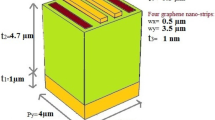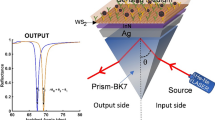Abstract
In this paper, we propose a new plasmonic metamaterial-based biosensor using graphene-coated titanium nitride nano-cuboids with a tunable absorbance peak for the use in the first biological window in the infrared region between 830 and 950 nm. Using the finite element simulations, we study the absorbance of the proposed graphene/TiN hybrid metamaterial and demonstrate the possibility of achieving narrow and sensitive peaks to ambient medium index of refraction. The proposed nanostructure is highly tunable across the first biological window as the optical response of the metamaterial can be simply adjusted by varying the bias voltage of graphene nano-films. We demonstrate that graphene coating of the titanium nitride nano-films not only introduce tunability in the structure, but also improves the average absorption of the metamaterial by more than 20%, and the sensitivity by more than double while acting as a surface protection layer for the TiN nano-cuboids. The optimized structure demonstrates an average linear spectral sensitivity of 1014 nm/RIU, and a detection limit of 9.86 × 10–6 RIU has been obtained for RI variations between 1.3 and 1.42. The proposed structure also demonstrates an amplitude sensitivity of 5 RIU−1 with 850 nm excitation in IR region for liquid analytes. We also showed that the proposed sensor has a linear response for small variations in analyte RI with a tunable peak in IR region. This enables the development of a highly tunable and accurate refractometer for the detection of biomaterials, biological molecules, and liquid analytes in the infrared region. Finally, we demonstrate that small variation in design parameters due to fabrication-induced imperfection does not change the sensing performance of the proposed biosensor, resulting in a viable platform for sensing and narrowband applications with higher stability, sensitivity, and durability than previously reported structures based on traditional plasmonic materials like gold and silver.







Similar content being viewed by others
Data Availability
No datasets were generated or analysed during the current study.
References
Hamza ME, Othman MA, Swillam MA (2022) Plasmonic biosensors: Review. Biology 11:621
Singh AK, Mittal S, Das M, Saharia A, Tiwari M (2023) Optical biosensors: A decade in review. Alex Eng J 67(15):673–791
Li R, Fan H, Chen Y, Huang J, Liu GL, Huang L (2023) Application of nanoplasmonic biosensors based on nanoarrays in biological and chemical detection. Opt Express 31:21586–21613
Naresh V, Lee N (2021) A review on biosensors and recent development of nanostructured materials-enabled biosensors. Sensors 21:1109
Azuelos P, Girault P, Lorrain N, Poffo L, Guendouz M, Thual M, Lemaître J, Pirasteh P, Hardy I, Charrier J (2017) High sensitivity optical biosensor based on polymer materials and using the Vernier effect. Opt Express 25:30799–30806
Chen S, Lin H, Wang X, Hu S, Luo Y (2023) Enhanced sensitivity of a surface plasmon resonance biosensor utilizing Au/ITO hyperbolic metamaterial. Results in Phys 49
Qasymeh M (2014) Photorefractive effect in plasmonic waveguides. IEEE J Quantum Electron 50(5):327–333
Monfared YE (2020) Refractive index sensor based on surface plasmon resonance excitation in a D-shaped photonic crystal fiber coated by titanium nitride. Plasmonics 15:535–542
Monfared YE, Qasymeh M (2021) Graphene-assisted infrared plasmonic metamaterial absorber for gas detection. Results in Phys 23
Chemerkouh MJHN, Saadatmand SB, Hamidi SM (2022) Ultra-high-sensitive biosensor based on SrTiO3 and two-dimensional materials: Ellipsometric concepts. Opt Mater Express 12:2609–2622
Saadatmand SB, Chemerkouh MJHN, Ahmadi V, Hamidi SM (2023) Design and analysis of highly sensitive plasmonic sensor based on 2-D inorganic Ti-MXene and SrTiO3 interlayer. IEEE Sensors 23(12):12727–12735
Saadatmand SB, Chemerkouh MJHN, Ahmadi V, Hamidi SM (2023) Graphene-based integrated plasmonic sensor with application in biomolecule detection. J Opt Soc Am B 40:1–10
Li L, Liang Y, Guang J, Cui W, Zhang X, Masson J, Peng W (2017) Dual Kretschmann and Otto configuration fiber surface plasmon resonance biosensor. Opt Express 25:26950–26957
Afsheen S, Iqbal T, Aftab M, Bashir A, Tehseen A, Khan MY, Ijaz M (2019) Modeling of 1D Au plasmonic grating as efficient gas sensor. Mater Res Express 6
Zhang Y, Yia Z, Wang X, Chua P, Yao W, Zhou Z, Cheng S, Liu Z, Wu P, Pan M, Yie Y (2021) Dual band visible metamaterial absorbers based on four identical ring patches. Phys E 127
He Y, Deng H, Jiao X, He S, Gao J, Yang X (2013) Infrared perfect absorber based on nanowire metamaterial cavities. Opt Lett 38:1179–1181
Qin Z, Shi X, Yang F, Hou E, Meng D, Sun C, Dai R, Zhang S, Liu H, Xu H, Liang Z (2022) Multi-mode plasmonic resonance broadband LWIR metamaterial absorber based on lossy metal ring. Opt Express 30:473–483
Raad SH, Atlasbaf Z, Monti A, Toscano A, Bilotti F (2022) On the surface impedance modeling of metasurfaces composed of graphene-coated spherical nanoparticles. J Opt Soc Am B 39:917–923
Bower R, McPolin CPT, Krasavin AV, Zayats AV, Petrov PK (2022) Temperature stability of individual plasmonic Au and TiN nanodiscs. Opt Mater Express 12:3471–3479
Pflüger J, Fink J (1991) Determination of optical constants by high-energy, electron-energy-loss spectroscopy (EELS). In: Palik Edward D (ed) Handbook of optical constants of solids II. Academic Press, pp 293–310
Dodge MJ (1986) "Refractive index" in Handbook of Laser Science and Technology, Volume IV, Optical Materials: Part 2, CRC Press, Boca Raton, 30
Tamma VA, Cui Y, Park W (2013) Scattering reduction at near-infrared frequencies using plasmonic nanostructures. Opt Express 21:1041–1056
Saeed M, Alshammari Y, Majeed SA, Al-Nasrallah E (2020) Chemical vapour deposition of graphene-synthesis, characterisation, and applications: A review. Molecules 25(17):3856
Najim A, Bajjou O, Boulghallat M, Rahmani K, Moulaoui L (2022) DFT study on electronic and optical properties of graphene under an external electric field. E3S Web Conf 336:00006
Funding
This research is supported by the ASPIRE Award for Research Excellence under the Advanced Technology Research Council (ASPIRE) (AARE19-062) 2019.
Author information
Authors and Affiliations
Contributions
Y.M. and M.Q. contributed equally and wrote the main manuscript text.
Corresponding author
Ethics declarations
Competing Interests
The authors declare no competing interests.
Additional information
Publisher's Note
Springer Nature remains neutral with regard to jurisdictional claims in published maps and institutional affiliations.
Rights and permissions
Springer Nature or its licensor (e.g. a society or other partner) holds exclusive rights to this article under a publishing agreement with the author(s) or other rightsholder(s); author self-archiving of the accepted manuscript version of this article is solely governed by the terms of such publishing agreement and applicable law.
About this article
Cite this article
Monfared, Y.E., Qasymeh, M. Graphene/Titanium Nitride Hybrid Nano-cuboid Plasmonic Metamaterial–Based Biosensor for Highly Sensitive and Tunable Infrared Detection. Plasmonics (2024). https://doi.org/10.1007/s11468-024-02402-5
Received:
Accepted:
Published:
DOI: https://doi.org/10.1007/s11468-024-02402-5




